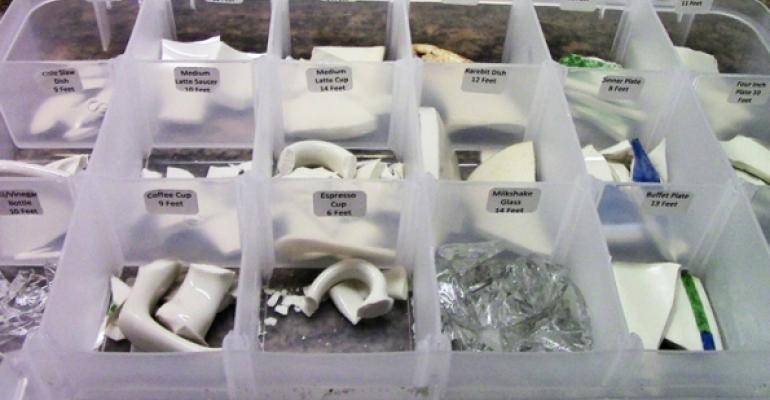Goal: To reduce incidences of food adulteration by foreign objects, such as glass, and fraudulent claims about such problems.
Running restaurants may not require a degree in rocket science, but at least one department at the 75-unit Eat’n Park family-dining chain is taking a NASA-like approach to its work.
Bill Moore, director of safety and security for Homestead, Pa.-based Eat’n Park Hospitality Group, is borrowing a playbook page from NASA as part of a three-pronged strategy to reduce incidences of foreign objects finding their way into food, as well as fraudulent claims about such occurrences.
Solution: Catalog everything that might break, and install video cameras.
“Whenever NASA has a shuttle go down or any airliner goes down, investigators find all the missing pieces and catalog every screw that was in that shuttle or airplane,” Moore explained. “We’re saying, ‘OK, let’s look at every piece of glass [or china] we have in our facility, let’s look at every piece of wood that can come off, and let’s look at every screw that might fall into a drink. Let’s make sure we know [in advance] what can happen and where something can come from.”
Eat’n Park also replaced some types of glassware with attractive, shatter-resistant plastic products to reduce the amount of possible adulterant source materials in its restaurants, Moore said. And the chain reviews security camera video footage when diners claim to have suffered from adulterated food.
Moore did not provide details about the annual number of consumer requests for compensation tied to verified or alleged incidences of foreign objects in food, but offered that when you operate nearly 80 restaurants, “It can add up.”
He said that those measures “have really helped us reduce our claims, as far as foreign objects found in food are concerned.”
In addition to cataloging Eat’n Park’s dishware and some building materials and equipment pieces, Moore’s group studied how each type of dishware reacted when dropped on a hard surface from a height of 3 feet. Michael Galterio, the chain’s food-code specialist, then documented such metrics as the distance pieces flew when each type of dishware shattered.
Moore said data from the distance analysis were incorporated into a chart now used as part of the food safety curriculum presented to about 500 managers and other key employees annually.

The key underlying training messages to come from that analysis are that when you break a dish, you have to not only clean that area, but also “go 10 to 12 feet out, [and] food that is uncovered [in the vicinity] has to be thrown away.”
The pieces left over from the breakage research were stored in labeled bins in a plastic box at headquarters so that they can easily be retrieved for comparison with objects guests report finding in their food, Moore said.
“It gives you a place to start an investigation,” he said. “You can say, ‘This piece did come from our restaurant,’ or, ‘This piece did not, so maybe we need to go back to the [food] manufacturer.’”
In instances when an object submitted by a consumer does not match one of Eat’n Park’s cataloged materials, nor does it match materials found at the manufacturer’s plant, the possibility of fraud must be considered, Moore said. And Eat’n Park has caught some individuals in the act of trying to defraud the chain.
“We have caught a couple of people putting stuff in food through the use of our video security cameras,” Moore said.
But as telling as what the camera footage has revealed is what it has not: Some customers who claim to have found foreign objects in their food and even to have broken a tooth “didn’t even flinch” during the purported ordeal, he said.
Contact Alan J. Liddle at [email protected].
Follow him on Twitter: @AJ_NRN.

